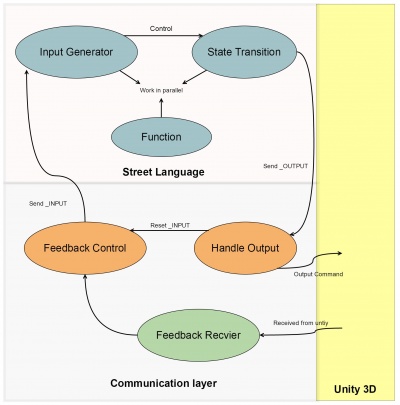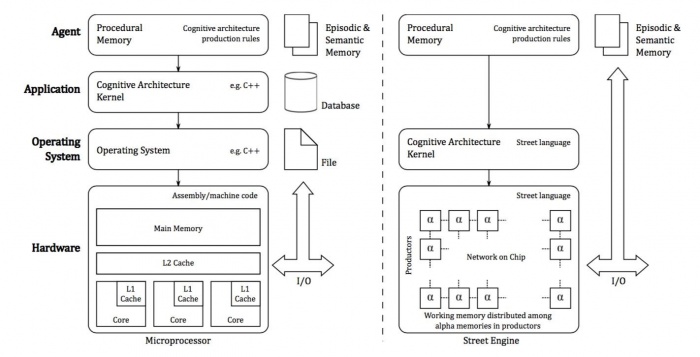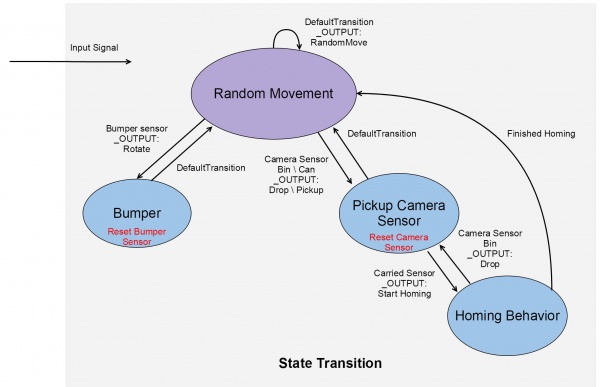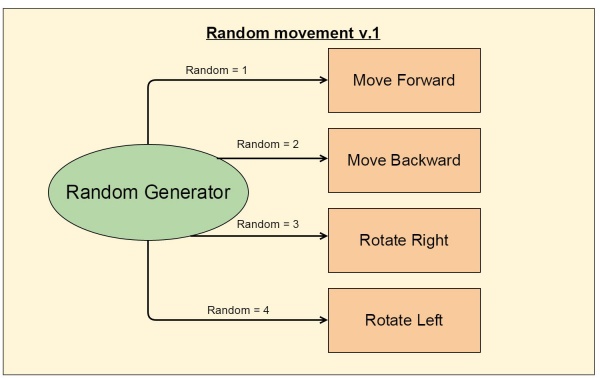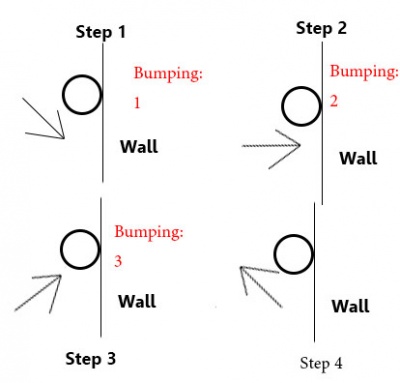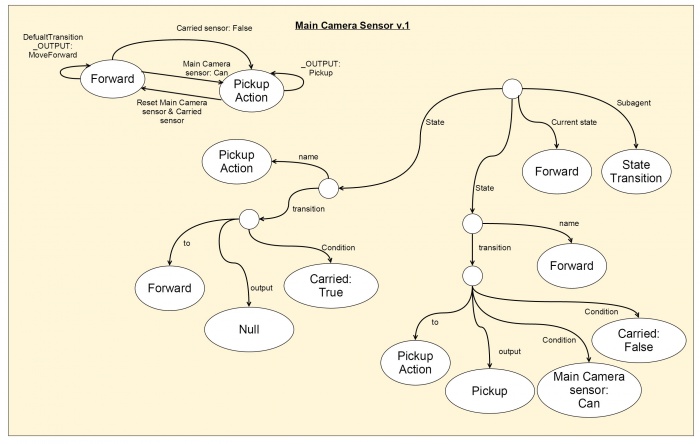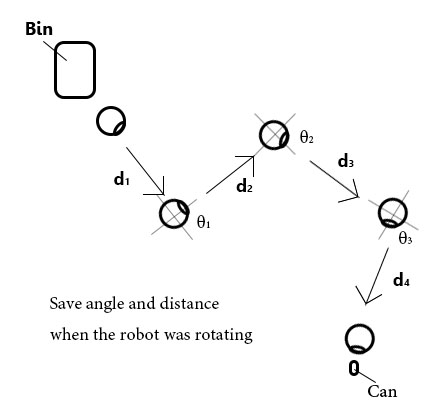Projects:2015s1-15 AI for a Trash Collecting Robot
Contents
Project Information
The purpose of this project proposal is to present a project plan for the objective of creating an AI for the Trash Collecting Robot project as well as to describe the proposed strategy to achieve the project goal. The goal of this project is to test and design the Street Engine that will it work in the real life. It is an experiment for testing Street Engine, which created by the University of Adelaide [1]. The aim of this project is to design and construct an agent-based AI using the newly founded Street Language. Moreover, the project team can combine some of the behaviour from different animals or insects to improve the AI.
Environment
The AI for the autonomous robot is to be designed, programmed and tested in a Virtual Reality Development Environment (VRDE) before being implemented and tested on a physical robot.
Virtual Robot Development Environment
The VRDE is where the robot’s AI performance will be tested. The VRDE will simulate real life environment so that the AI can be tested in virtual reality to analyze and evaluate its performance. The simulated environment can be modified to simulate different scenarios for different test purpose. The VRDE was created by the previous team using Unity3D game engine [3]. Unity3D is a game engine to design a 2D or 3D game. In this project, it will become the interface of virtual robot and an experiment platform of Street Engine. The justification of using Unity3D is that it can support two program language to run in one project, which are JavaScript and C#.
Unity-JavaStreet Communication Layer
The Communication layer is the nerve of the robot. It convert and pass through the signal between AI agent and VRDE. This is an important system to success the project. The communication layer receive and convert all the feedback from unity in JSON formal, then it pass the condition token to AgentStreet. Also, it will receive the output token from AgentStreet and convert it into JSON formal, then send it into VRDE. JSON is a language-independent date format to use for data transfer in the network. The benefit of using JSON to transfer the data between Unity and Communication layer is that the JSON data can apply with many programming language.
AI Agent (JavaStreet)
The AI agent is the brain of the robot. It manage all the inputs and outputs as well as make decisions and execute tasks for the robot which makes it the very definition of an autonomous trash collecting robot [2]. The agent will be programmed using Street Language and implemented using JavaStreet. Street Language is a new programming language for the processer, and the operation of processer is running in parallel. The basic idea of street language is that it will take all of the condition in working memory and then find the matched condition requirement and vary the working memory, such as ‘if’ loop.
As there are currently no test available for implementation, a project was set up to create a basic performance test bench for the computer. The project was chosen to be an automated trash collecting robot as this would test the autonomy and cognitive capability of the computer to make decisions as well as handle input and output data.
Outcomes
JavaStreet Design Structure
The JavaStreet Design Structure is a concept structure of Street Language and Communication layer, and the design base on the state machine given by Braden [18]. It will include all the subsystem and the relationship between those subsystems in AgentStreet.
Random Movement
The Random movement is the basic design of the robot movement and use for testing with other design, such as Bumper Sensor, Pickup and Drop etc. This function will be replaced by foraging behavior in the future.
Bumper function
The Bumper function can able to protect the robot and avoid the collision. This idea based on the behavior of bat and cat [6, 7]. Once the robot was colliding the wall or obstacle, this action state should be able to avoid the collision again. In the version 3 of bumper function, the robot only rotate 45 degree on the left hand side and back to the forward function.
The robot may bump the wall at the same position in the quadrilateral place, and it may have a forever loop in the robot’s track by applying forward & bumper sensor only. The ideal diagram of that issue shown as below.
Pickup and Drop/ Main Camera Sensor
Pickup and Drop-trash are basic set up function for the robot. This function will handle the action of pick-up and drop-trash in AgentStreet.
Basic Homing Vector
The idea of homing vector based on the homing behavior of ant and Monarch butterflies. The homing behavior will separate into two part, which are ‘basic homing’ and ‘homing vector’, in order to it will be design the structure easily in street language.
Team
Students
- Eik Xiang Yu
- Keng Nam Leung
Supervisors
- Dr Braden Phillips
- Mr Mike Liebelt
Reference
[1] Jesse F, Mostafa W. N, Michael L and Braden J. P (2014), ‘A New Computer for Cognitive Computing’, The University of Adelaide.
[2] Murphy, RR, 1998, Introduction to AI Robotics, The MIT Press, London
[3] Reece, D, Liu, SS, 2014, ‘Projects:2014S1-24 AI Agent Development for an Autonomous Trash Collecting Robot’, https://www.eleceng.adelaide.edu.au/students/wiki/projects/index.php/Projects:2 014S1- 24_AI_Agent_Development_for_an_Autonomous_Trash_Collecting_Robot
[4] Nilsson, NJ, 1933, Principles of Artificial Intelligence, Morgan Kaufmann Publisher, California
[5] Hurwitz, J, Kaufman, M, Bowles, A, 2015, ‘Cognitive Computing and Big Data Analytics’, John Wiley & Sons, Indianapolis
[6] Tadeusz G; Joanna F; Krzysztof H, (2011), “Bats Sonar Calls and its Application in Sonar Systems”, Sonar Systems, Prof. Nikolai Kolev (Ed.), ISBN: 978-953-307-345-3,InTech,Availablefrom: http://www.intechopen.com/books/sonar- systems/bats-sonar-calls-and-its-application-in-sonar-systems
[7] Kargo, W. J; Giszter, S.F (January 1, 2000), “Rapid Correction of Aimed Movements by Summation of Force-Field Primitives”, the Official Journal of the Society for Neuroscience, Vol. 20(1), pp. 409-26.
[8] Matthew S, (2014), “Telecommunications Principles”, the University of Adelaide, pp. 123-130.
[9] Henrik M; Barrie J. F, (28 May 2002), “Virtual migration in tethered flying monarch butterflies reveals their orientation mechanisms”, Department of Psychology, Queen’s University, vol. 99, no. 15, pp. 10162-10166.
[10] Jason A. E; Sandra M. P; Orley R. T; Rudolf J, (10 March 1999), “Monarch butterflies (Danaus plexippus L.) use a magnetic compass for navigation”, Department of Entomology, University of Kansas, vol. 96, no. 24, pp. 13845-13846.
[11] “Search techniques”, (January 2010), CRV Crew Training Manual, pp. 165-188, Available from: http://coastguardsouthernregion.wikispaces.com/file/view/Search+Techniques.pdf
[12] Associated P, (15 March 2014), “Hijacked Plane News: Missing Malaysia Airlines Flight MH370 Hijacked, Official Says”, EPOCH TIMES, Available from: http://www.theepochtimes.com/n3/563481-hijacked-plane-news-missing-malaysia-airlines-flight-mh370-hijacked-official-says/
[13] Soza & Company, Ltd. and Office of Search and Rescue U.S. Coast Guard, (October 1996), “The Theory of Search: A Simplified Explanation”, Available from: http://www.navcen.uscg.gov/pdf/Theory_of_Search.pdf
[14] Edmund R. H; Thomas O; Gregory F. A; Tamsyn H. B; Mike G; Nigel R. F, (1 December 2014), “Ants show a leftward turning bias when exploring unknown nest sites”, Department of Zoology, University of Oxford, Biol. Lett. 10: 20140945. Available from: http://dx.doi.org/10.1098/rsbl.2014.0945
[15] Engber, D, (16 November 2011), “The End of the Maze – How the rodent labyrinth fell out of favor”, The Slate Group, a Graham Holdings Company, Retrieved 27 March 2015.
[16] Richard M, (3 April 1984), “Developments of a water-maze procedure for studying spatial learning in the rat”, Jourmd of Neurowience Method, vol.11, pp.47-60.
[17] Leffingwell, D, 2010, Agile Software Requirements: Lean Requirements Practices for Teams, Programs, and the Enterprise, Pearson, Boston
[18] Braden J. P (20 February 2015), ‘A Brief Description of Street Language’, The University of Adelaide.
[19] Rudiger W; Wolfgang R (2013), ‘Bounded Plasticity in the Desert Ant’s Navigational Tool Kit’, University of Zurieh, University of Wurzburg, pp 514-522
[20] Rudiger W; Martin B; Florian L; Stefan S; Ursula M (10 January 2006), ‘Ant Navigation: One-Way Routes Rather Than Maps’, University of Zurieh, pp. 75-79
